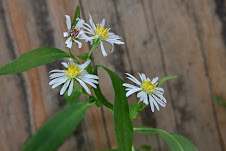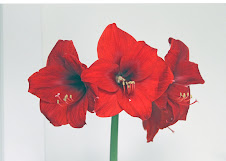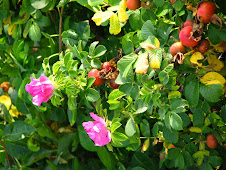Plantain is a perennial herb with basal leaves and
inconspicuous flowers in spikes or heads.
These wildflowers probably can be found in everyone’s yard or
field. The plant was introduced into the
new world by colonist from Europe. So it
first common names were “Englishman’s foot” or “White Man’s Foot”. The most common species in North America are Plantain major, the broad-leaved or
common plantain, and Plantain lanceolat,
the narrow-leaved English plantain.
In the spring the plant sprouts from its taproots or seeds. From early summer to late fall leafless flower
stalks arise from the center of the rosette of leaves. The tiny flowers are greenish white and become
a seedpod of 10 to 20 seeds. Most people treat this plant as a weed; since
it grows everywhere in most soil and light conditions.
However to many this is a miracle plant. Native Americans used the powdered roots of
Plantain as anti-venom for rattlesnake bites and the plant earned the name of
“Snake Weed”. In Europe the plant was
used for skin diseases and bites.
The very young leaves can be used in salads or cooked as
greens. The larger older leaves are used
for tea. The leaves are high in beta carotene
(vitamin A), vitamin B1, riboflavin, calcium, and ascorbic acid (vitamin C).
The young flower stalks of common plantain may be eaten raw
or cooked and taste like asparagus. The
seeds may be added to food or ground into flour. You may be familiar with Metamucil. This laxative’s primary ingredient is from
the seeds of a related species (Plantain psyllium).
There are medical benefits from all parts of the plant. A tea made from the leaves or the whole plant
can treat lung disorders, stomach problems and skin diseases and
irritations. Chewing on a leaf not only
refreshes your breath, but may discourage your desire to smoke cigarettes.
According to the School of Pharmacy at the University of Oslo, Norway “the leaves have been used as a wound healing remedy for centuries
in almost all parts of the world and in the treatment of a number of diseases
apart from wound healing”. So, if you
are outside and receive a bug bite or sting; chew a leaf and place on your
sore.
Plantain ointment and Plantain extract may be ordered online
from several vitamin companies.
This plant also provides food for butterfly caterpillars,
rabbits, deer, grouse, and other birds.
I used to constantly remove some of my numerous Plantain
plants, keeping the larger ones, which are easier for me to grow than the
flamboyant slug attractant Hosta. I look
forward to this coming spring when I will be picking the young Plantain leaves
for a salad.



















LP_gardening_2666.jpg)
LP_gardening_2668.jpg)

LP_garden_2819.jpg)

LP_flower_0563.jpg)
LP_flower_0577.jpg)
LP_flower_0545.jpg)
LP_flower_0555.jpg)
LP_flower_0539.jpg)
LP_dog_0470.jpg)
LP_snow_0467.jpg)
LP_dog_0349.jpg)
LP_tree_8153.jpg)
LP_5028.jpg)
LP_flowers_3940.jpg)

LP-grass_0889.jpg)
LP_redfox_1651.jpg)
LP_squirrel_6978.jpg)
LP_flower_6936.jpg)
LP_squirrel_6864.jpg)
LP-deer_4773.jpg)
LP_4521.jpg)
LP_1251.jpg)
LP_4585.jpg)
LP_3784.jpg)
LP_3759.jpg)
LP_3811.jpg)
LP_3816.jpg)
LP_3847.jpg)
LP_0870.jpg)
LP_4183.jpg)
LP_0891.jpg)
LP_3175.jpg)
LP_3577.jpg)

LP_3068.jpg)
LP_3058.jpg)
LP_3562.jpg)
LP_0118.jpg)
LP_3407.jpg)
LP_3150.jpg)
LP_3011+(2).jpg)
LP_3020.jpg)
LP_2830.jpg)
LP_2782.jpg)
LP_2828.jpg)
LP_1746.jpg)
LP_2648.jpg)
LP_2666.jpg)
LP_2668.jpg)
LP_2493.jpg)
LP_2611crop.jpg)


LP_2588.jpg)






LP_2126.jpg)
LP_2122.jpg)






No comments:
Post a Comment